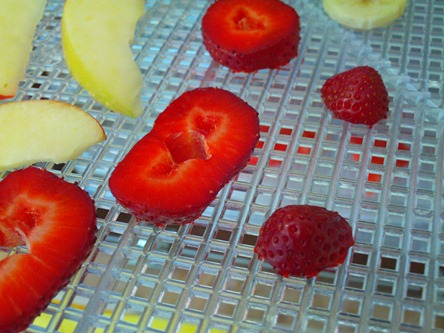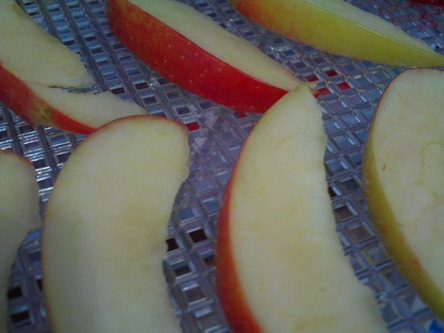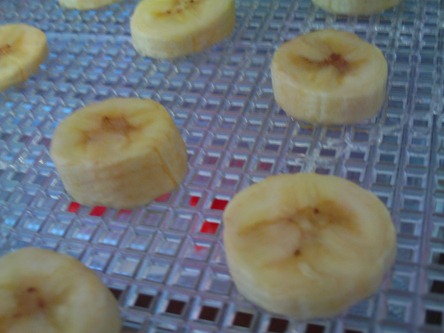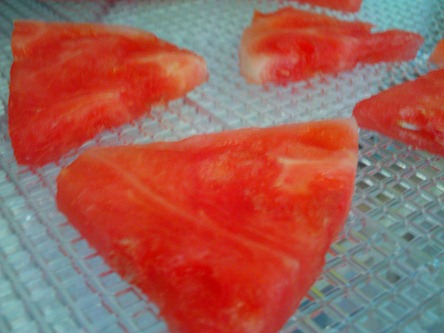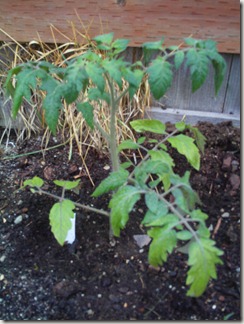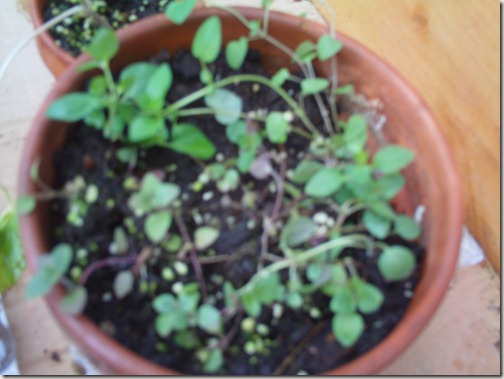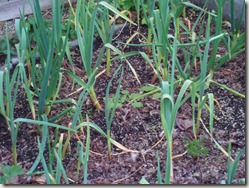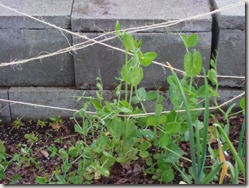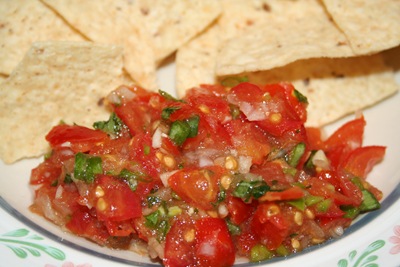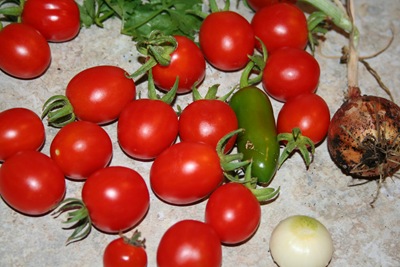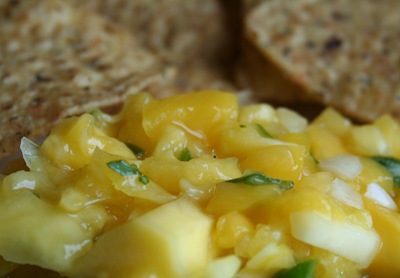More Fun with Food Dehydrator
14 years ago dehydrator, herbs, strawberries
I decided to be adventurous with the food dehydrator and grabbed some stuff from the refrigerator to make some nice nutritional snacks.
I started with some strawberries, the process is very simple, take some strawberries slice about 1/4 inch thick and place on the tray.
Next I moved on to apples which I soaked in a solution of lemon juice (about 1/4 cup) with 1 cup of water. To add a little extra sweetness I also dumped in a packet of artificial sweetener to reduce the sourness from lemon. After letting the apples soak in this solution for about 3 minutes I added them to the tray.
After slicing bananas about 1/4 inch thick I also soaked these in the same lemonade bath I did for the apples for 3 minutes as well.
Finally I spliced some watermelon at the same approximately 1/4 inch thickness while removing as many seeds as possible and then placing the slices on the trays and moving them into the dehydrator preheated at 100 degrees F.
After about 24 hours the apples were ready and very delicious, these did not last wrong. Next came the strawberries which tasted ok, but were very difficult and basically not worth the time to attempt to wedge from tray and eventually gave up a through most of these away. This was followed by the watermelon which wasn’t quite as messy and tasted like semisweet candy with a light watermelon flavor which seems about right since watermelon does not have nearly as strong a flavor naturally as you would get in artificially sweetened gum or candy. Lastly were the banana chips which were good and were all eaten though for the long time required to dry I probably will opt to buy the non-fried version of these at the store.
Overall it was fun to make these but apples will probably be the only ones in a future rotation but looking forward to drying some garlic, onions, and herbs later this year.
Tags: cheap, garden seeds, garlic bulbs, herb garden, strawberry plants, vegetables
Earth Day in the garden
14 years ago cilantro, cold season crops, garlic bulbs, onions, peppers, tomato
I decided to take the day off to catch up on some things at home and as I ended up outside of course I went right to the garden.
We have seen a few warm days here in the Northwest and in my area we haven’t dipped under 40 degrees at night so seemed like a good time to plant a few of my tomatoes spending their time this winter in the grow box.
Above are a New Yorker and Persey both of which are new for me this year. They have been growing great even with my neglect during their youth. I also have some Green Zebras, Husky Cherry, Sweetie Cherry, and Yellow Cherry. I did attempt Red Brandywine but the seeds I got appear to be duds.
Given it is always good to have a Plan B so I have twins of these tomato plants still in puts which I can bring if a cold snap comes and kills off the plants I ambitiously planted in the ground.
Elsewhere in the garden I have some herbs: Parsley and Oregano, with Basil being an unfortunately casualty which I will plan on buying from the store and try again next year.
Next I checked out my larger garden bed to see my peas, cilantro, onions, carrots, lettuce, strawberries and garlic
Lastly I checked out the peppers in the grow box which they will stay until we have some warmer nights (at least 50 degrees) otherwise can cause significant stunting of growth. So until then they will remain happy in the grow box and given they are still pretty small, still plenty of room to grow…
Tags: cheap, cilantro, garden seeds, garlic bulbs, growbox, herb garden, outdoor plants, pepper plants, strawberry plants, tomato plants, vegetables
Attack of the garlic
14.1 years ago garlic bulbs, spinach
I either forgot to harvest a couple bulbs of garlic, or the mild winter we had in the Northwest may have allowed the garlic I planted last fall to slowly develop some bulbs. Thinking the first option is more likely, but did present me with a problem of some very tightly grouped garlic.
Fortunately the solution to this problem was very simple. I pulled up the garlic bunches and gently separated the individual garlic plants. Finally I carefully replanted at much better spacing and followed up with a little watering. The unfortunate side effect is now I have 75% of my cold weather plot growing garlic. On the positively side with proper preparation garlic stores well and I can definitely feel less guilty harvesting some of my garlic before they start developing bulbs.
Also provided that garlic does not require a lot of root space I should be able to plant some random veggies between them.
Tags: cheap, garlic bulbs, led, outdoor plants, vegetables
pH needs of plants in soil or hydroponics
14.3 years ago hydroponics, pH, water
With the exception of some of my acid loving plants and flowers I normally do not have to worry much about the pH of my soil. This is because I have amended my gardens with nutrient rich soils in raised beds over my alkaline clay I get naturally in my area. This and the fact that due to natural and manmade causes the rainfall is slightly acidic and given the average range for the sweet spot of most edible vegetables (see table below) is 5.8 to 6.0 having your soil slightly acidic this is perfect.
Now when it comes to hydroponics this is entirely different. My tap water has a pH of around 7.5 and the fluctuation of plant using nutrients and transpiration can cause great havoc on the pH on your hydroponic system. Now this creates a challenge but also an opportunity to have control with great precision your pH and keep your plants growing in the sweet spot for the healthiest plants and the greatest yields.
So whether you are growing hydroponically, or simply trying to figure out why your Fennel didn’t do so well last year take a look at the table below, hopefully for some hints of what happened.
Recommended pH Ranges of Vegetables/Herbs
| Plant | Low | High | Plant | Low | High | |
| Artichoke | 6.5 | 7.5 | Millet | 6.0 | 6.5 | |
| Asparagus | 6.0 | 8.0 | Mint | 7.0 | 8.0 | |
| Average | 6.3 | 7.8 | Mushroom | 6.5 | 7.5 | |
| Basil | 5.5 | 6.5 | Mustard | 6.0 | 7.5 | |
| Bean | 6.0 | 7.5 | Okra | 5.5 | 6.0 | |
| Beanroot | 6.0 | 7.5 | Olive | 5.5 | 6.5 | |
| Beet | 6.0 | 6.8 | Onion | 5.5 | 6.5 | |
| Broccoli | 6.0 | 6.8 | Paprika | 7.0 | 8.5 | |
| Brussel Sprouts | 6.0 | 6.8 | Parsley | 5.0 | 7.0 | |
| Cabbage | 6.0 | 6.8 | Parsnip | 6.0 | 6.8 | |
| Calabrese | 6.5 | 7.5 | Pea | 5.8 | 7.0 | |
| Carrot | 6.0 | 6.8 | Peanut | 5.0 | 6.5 | |
| Cauliflower | 6.0 | 6.8 | Pepper | 5.5 | 6.0 | |
| Celery | 6.0 | 6.5 | Peppermint | 6.0 | 7.5 | |
| Chicory | 5.0 | 6.5 | Pistacio | 5.0 | 6.0 | |
| Chinese Cabbage | 6.0 | 7.5 | Potato | 4.5 | 6.5 | |
| Chives | 6.0 | 7.0 | Potato, Sweet | 4.5 | 6.0 | |
| Corn Salad | 6.0 | 6.5 | Pumpkin | 6.0 | 6.8 | |
| Corn, Sweet | 5.8 | 6.8 | Radish | 6.0 | 6.8 | |
| Courgettes | 5.5 | 7.0 | Rice | 5.0 | 6.5 | |
| Cress | 6.0 | 7.0 | Rosemary | 5.0 | 6.0 | |
| Cucumber | 6.0 | 6.8 | Rutabaga | 6.0 | 6.8 | |
| Eggplant | 5.5 | 6.0 | Sage | 5.5 | 6.5 | |
| Fennel | 5.0 | 6.0 | Shallot | 5.5 | 7.0 | |
| Garlic | 5.5 | 7.5 | Sorghum | 5.5 | 7.5 | |
| Ginger | 6.0 | 8.0 | Soybean | 5.5 | 6.5 | |
| Horseradish | 6.0 | 7.0 | Spearmint | 5.5 | 7.5 | |
| Kale | 6.0 | 7.5 | Spinach | 6.0 | 6.5 | |
| Kohlrabi | 6.0 | 6.8 | Squash | 6.0 | 6.8 | |
| Leek | 6.0 | 8.0 | Swede | 5.5 | 7.0 | |
| Lentil | 5.5 | 7.0 | Swiss Chard | 6.0 | 6.5 | |
| Lettuce | 6.0 | 6.5 | Thyme | 5.5 | 7.0 | |
| Marjoram | 6.0 | 7.5 | Tomato | 6.0 | 6.5 | |
| Marrow | 6.0 | 7.5 | Turnip | 6.0 | 6.8 | |
| Melon | 6.0 | 6.8 | Upland Cress | 6.0 | 6.5 |
Tags: garlic bulbs, herb garden, outdoor plants, pepper plants, peppermint plant, tomato plants, vegetables
Garden Salsa recipe
14.7 years ago cilantro, garlic bulbs, harvest, onions, recipe, tomato
Big moment this week, I was able to make salsa entirely from ingredients. I normally don’t use cherry/grape tomatoes for salsa but my Early Girls are not that early this year and have not quite turned red.
CVG Garden Salsa Recipe
- 2-3 tomatoes (or 12-15 cherry/grape tomatoes)
- 2 cloves garlic
- 1 small onion
- green onion
- 5 sprigs of cilantro
- tablespoon vinegar
- 1 jalapeno pepper (seeded)
- sugar
Directions: Coarsely chop tomatoes (removing seeds, though if I few sneak in it is not a big deal), onion, and green onions and add to bowl. Finely chop garlic, cilantro, and seeded jalapeno pepper and add to mixture. Add vinegar to bowl and mix thoroughly. Let sit for 10 minutes and add sugar until salsa does not have a spicy aftertaste (normally 1-2 teaspoons) If you like the spice skip the sugar and include seeds from the jalapeno.
Tags: cilantro, garden seeds, garlic bulbs, pepper plants, salsa garden, tomato plants
Mango Salsa Recipe
I am starting to get some cherry tomatoes turning red but not enough to make salsa so yet again so I decided to make some Mango Salsa. It is great to eat on tortilla chips the same you would for regular salsa or black bean corn salsa. One of my favorite things to do with is as a topping to blackened salmon (salmon grilled with dusting of Cajun seasoning)
CVG Mango Salsa Recipe
- 3 mangos
- 2 cloves garlic
- 1 small onion
- green onion
- 5 sprigs of cilantro
- juice of one lemon (or lime)
- 1 jalapeno pepper (seeded)
- sugar
Directions: Finely chop 1 mango (or blend in blender/food processor) this will create a base for the salsa. Coarsely chop remaining mangos, onion, and green onions to have more defined texture and add to bowl. Finely chop garlic, cilantro, and seeded jalapeno pepper and add to mixture. Squeeze in juice of lemon into bowl and mix thoroughly. Let sit for 10 minutes and add sugar until salsa does not have a spicy aftertaste (normally 2-3 teaspoons)
Now if you really like the spice you can leave the seeds in and/or skip the sugar but for the blackened salmon it give a good contrast to the spicy meat and people just are not usually expecting fruit to be spicy.
I can proudly say with the exception of mangos, lemons, and sugar the remaining ingredients came right out of my garden.
Tags: cheap, cilantro, garden seeds, garlic bulbs, led, pepper plants, salsa garden, tomato plants, vegetables
